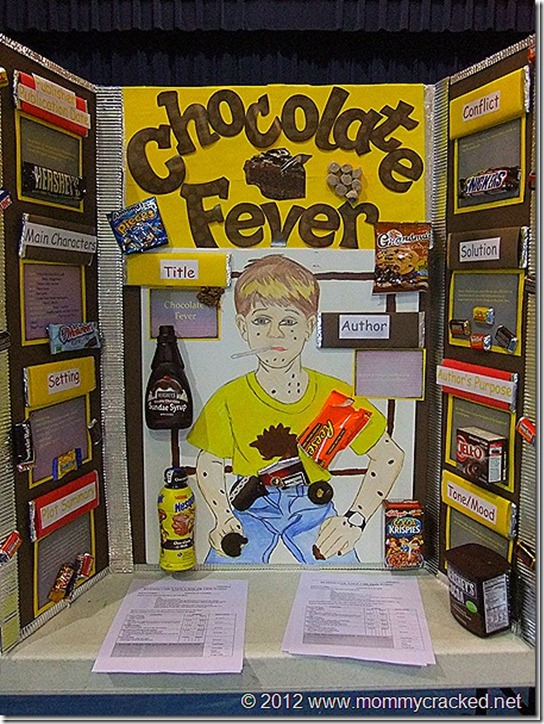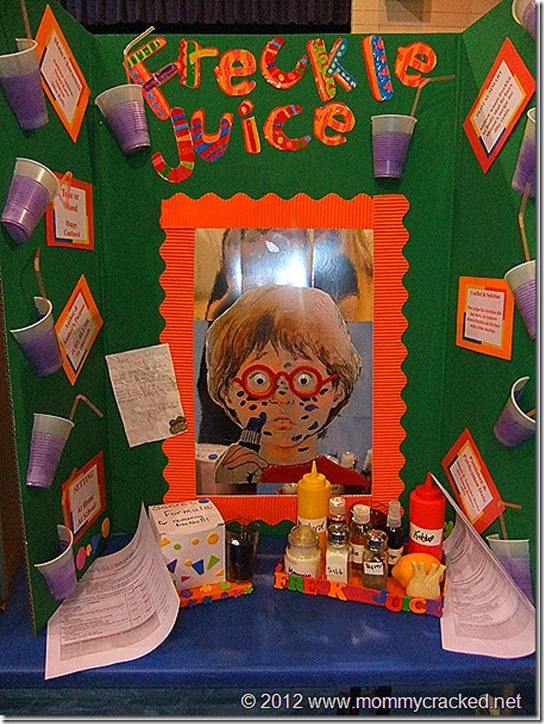Since the new year has started, I have received several emails asking me about the reading fair our school organizes each year. I’m always excited to talk about it because it’s one of the most fun things we do all year long and it really helps the children get creative while helping them develop an appreciation for reading. I thought I would go ahead and make a post about how to host a school reading fair so it would be easier to find in the future in case anyone happened to be searching for information about reading fair projects.
HOW TO HOST A SCHOOL READING FAIR
GETTING STARTED
The first thing we do is set a date for the school-wide reading fair. We send out information in late October and do the reading fair after the Christmas holidays so the kids can have a little extra time to complete their projects. We send the children home with a letter explaining the general purpose of the reading fair and the date and time it will be held.
We follow the basic guidelines as defined by the Mississippi Department of Education. We send each student home with a copy of these guidelines.
Students come to the library and check out a book for their reading fair projects. I always let them keep these books until after the reading fair because it’s for a special project, but some students choose to use a book they already have at home.
Students purchase a tri-fold project board to use as their storyboard.
I go ahead and purchase awards for 1st, 2nd, and 3rd place in each division or group. We use award ribbons and purchase them online, so be sure you order them in plenty of time.
GETTING TO WORK
I tell the students to be as creative as possible when designing their storyboards. As long as it’s within guidelines, anything goes! Borders, sequins, feathers, crayons, markers, and ANYTHING that captures the essence of the story and grabs attention while looking tasteful. Here are two really amazing storyboards that use lots of creativity:
I also tell my students NOT to write their names anywhere on the front of the board. I ask them to write their name in pencil real small on the back of the board.
Each fiction storyboard is labeled with the following story elements: Title, Author, Publisher and Publication Date, Main Characters, Setting, Plot Summary, Conflict, Solution, Author’s Purpose, Tone, or Mood. Non-fiction requirements can be found in the guidelines. Since we are an elementary school, we rarely have any non-fiction entries.
Our students complete their projects at home, but if you have time in your classrooms (and supplies), you could also help them at school.
BEFORE THE FAIR
Ask several people in your community who are not affiliated with the school (just to keep it fair) to come and judge the reading fair projects. Depending on the size of your school or how many students are participating, it’s good to have at least three judges for each division. Since our fair is small, we can get away with three judges in total. Judging usually takes them 2-3 hours total and then scores are tallied up. Ensure they know they may be at your school most of the day. If they have to stay through lunch, you might offer to purchase them a school lunch or allow them to leave to go and eat. You might also have sandwiches and chips for them. It’s entirely up to you.
Provide snacks and drinks/coffee for your judges. You might ask your PTO or fellow teachers to provide light snacks and drinks.
Make copies of score sheets for each judge and have them on a clip board waiting when they arrive.
Remind students about deadlines (I like to have all projects turned in a few days before the fair) and answer any last-minute questions.
Label each project board with numbers. Cover any names to keep judging fair. I just use small sticky notes to number each project since they remove easily without damaging the project. I place these sticky notes on the front of the board in a corner so the judges can find it easily.
THE DAY OF THE FAIR
Set up all the reading fair projects on tables according to their prospective grade levels or categories so they are almost at eye level. We use tables from our school library and classrooms and we set up in our school gym.
Have judges arrive about 30 minutes before start time, welcome them, let them grab a drink or some snacks if they want, and give them their clipboards and pencils. Let them know where restrooms and snacks are and let them know you are available to answer any questions. I also go over the judge’s score sheet with them so they understand how to fill it out correctly.
Once judges finish scoring all the boards, tally up the scores. Have as many calculators on hand as possible. You can ask the judges to do it or have other helpers available to do this part. Be sure to thank the judges and any helpers for their time.
Once winners are determined, we place their ribbons by their projects and announce the winners over the school intercom. You might consider having a short assembly to pass out awards. We also let all of the students come through the gym after the fair and see all of the projects. They love this and it even inspires some of those who chose not to participate to get excited about participating the next year.
Take pictures of the winners for local newspapers, class blogs, and school newsletters.
AFTER THE FAIR
Be sure and send a thank you note to all reading fair judges. We also gave our judges a little gift bag, but a thank-you note will suffice.
Our students who place first in their divisions move on to the district competition the following week. The district level is even more fun because there are even more great reading fair projects to check out.
I hope this explains in a little more detail how we hold our school’s reading fair. It’s not perfect by any means, but it works for our little school, and the kids really enjoy it and are so proud of their work. I also display many of their projects on top of my library shelves all year long. It really makes the library come alive and we get so many compliments on them when people visit our library.
Looking for more great reading fair inspiration? Start here. Also, be sure to follow me on Pinterest and never miss any reading fair news!



This is a fabulous idea! Students truly become. Engaged with reading! Would you be willing to share your rubrics, guidelines, etc. I am a first year teachers and would love to bring this to my school. We have A science fair for fifth and sixth graders, this would be great for the younger grades!
There is a link in this post that links to the MS Dept. of Education that contains the rubrics we use and the guidelines. Hope that helps! Thanks for stopping in.
Love this idea
HI. I love this idea. Thanks for being so passionate about reading and sharing this. Would you be willing to share your categories and score sheets? I teach middle school, in my second year, and would love to do something like this. Thanks again for the ideas.
Thanks for the information and instructions for the Reading Fair. What a fun idea! I think I’m going to do this on a simple level with only my homeroom class this upcoming school year. Since it will be my trial year, I will be able to work out any kinks before bringing the idea to my principal as a building-wide event. Even if we don’t end up using it as a competition for the school, it will still make a great display for parents to check out during one of our Family Nights! I teach fifth graders, and I think this would be a great culminating classroom activity to do once we’ve gone through our minilessons and guided groups on the elements of nonfiction.
Thanks Christi! I am sure your students will love this as much as mine did. It’s a really fun activity!
Great idea! Are all students required to participate or do families decide on their own if they want to take part? Thanks!
Hi Irene,
The students are not required to participate. Thanks for stopping in!
What is the accelerated reader program?
Hey Jenny! The Accelerated Reader program can be found here: http://www.renlearn.com// Basically, schools have to purchase this program for the kids to use, but it’s great! The children first take a STAR reading test to see at what level they read. Then, they select books based on that level, read them, and then take a computerized short quiz on what they read. We offer incentives for the kids when they meet their goals. The kids love it!
LOVE IT!
Thank You Mandy!! I was trying to figure out how to get started on this and this did the trick!!! The fair pics are awesome!
I was wondering about the papers I see on the tables in the pictures. What are those, and could I get copies? Thanks
Hi Lynda, those are judge’s rubrics and they can be found in the link (where it says “here” in the Getting Started section) in this post. Hope that helps! Thanks for stopping in!
I LOVE this idea! I can’t wait to see the pictures from today’s event!
What a GREAT way to get kids to read and actually absorb what they’re reading!! Our school did a contest this year – if each kid read for a total of 6 hours, they get a free ticket to Six Flags. My 3rd grader was really excited about that one.
Other than that, our schools put a huge emphasis on reading, which I am thankful for. Growing up, I hated reading, but so far my boys both really love it.
Oh Mandy, I love this idea and the projects your kids have done. I did something similar within my own classroom long ago, but this would be so much fun.
Thanks so much, Beth! We’re gearing up for ours on Friday. I can’t wait to share more pictures! It really is a lot of fun!